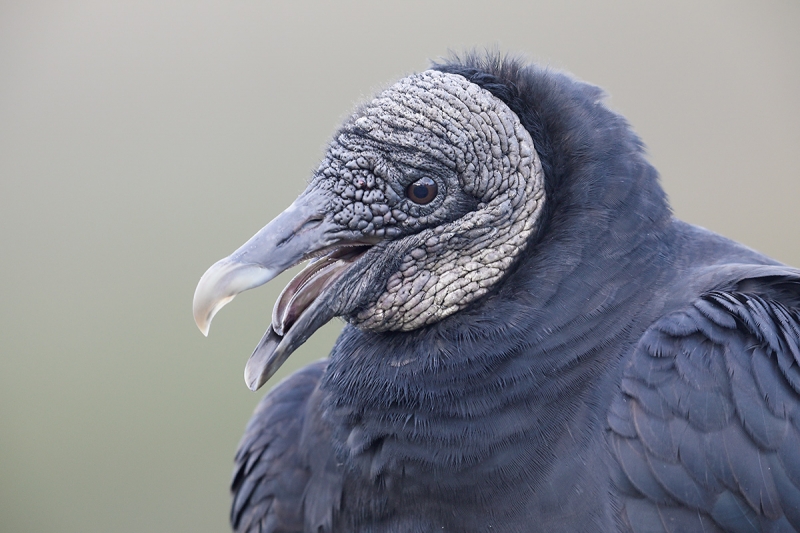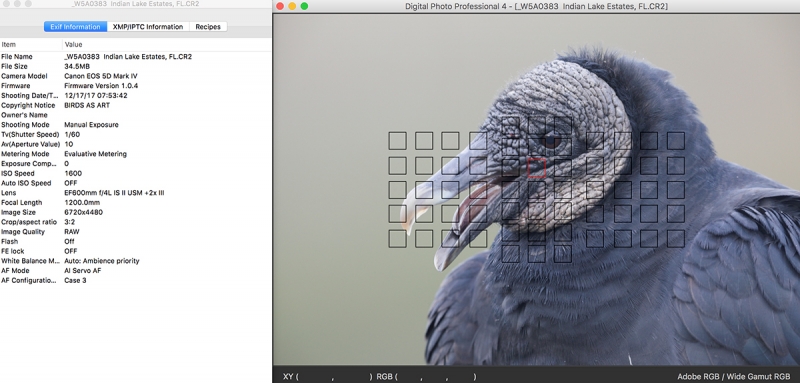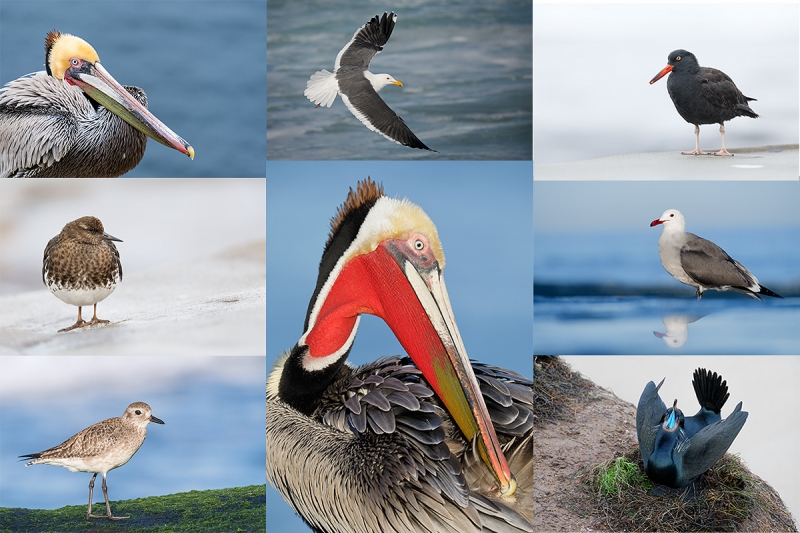Stuff
The 5D Mark IV User’s Guide is pretty much complete. I still have two sticky issues to deal with, and I need to review several edits. If you are entitled to a free copy and would like to review the 12/19 draft, please see the free 5D Mark IV User’s Guide offer below the 5D IV banner.
It has gotten so warm here that the past few mornings have been mega-foggy. On Tuesday an Osprey landed like an apparition out of the fog on a very tall skinny perch that had previously harbored only grackles. I photographed that bird and little else. Last night featured another lovely sunset but no birds were on any of the perches.
At 12:30, I swam my slow 3/4 mile in a positively toasty pool: 78 degrees. After lunch Jim drove me up to Winter Haven for my second SynVisc injection. It was much less painful than the first one. One more to go. They seem to be helping.
Click on the logo-link above for great holiday savings!
$300 off on the Canon 100-400 II!
$300 off on the Canon 100-400 II!
If you have sent me a FB friends request that has gone unrequited, it is because I am up to the 5,000 limit on my personal FB page. You are invited to click here and then Like and Follow the identical content. 🙂
The Streak
Today makes one hundred forty-five days in a row with a new educational blog post! This one took about two hours to prepare. With all of my upcoming free time (or not …), the plan right now is to break the current record streak of 480 … Good health and good internet connections willing.
Click here for Amazing 5D Mark IV Bundles and Deals
Booking.Com
Booking.Com came through for me twice again recently with both the DeSoto Fall IPT and next July’s UK Puffins, Gannets, and Bempton Pre-trip room reservations. And all the rates were great. If you’d like to give Booking.Com a shot, click here and you will earn a $25 reward. Thanks to the many who have already tried and used this great service.
Gear Questions and Advice
Too many folks attending BAA IPTs and dozens of folks whom I see in the field, and on BPN, are–out of ignorance–using the wrong gear especially when it comes to tripods and more especially, tripod heads… Please know that I am always glad to answer your gear questions via e-mail. Those questions might deal with systems, camera bodies, accessories, and/or lens choices and decisions.
|
|
|
This image was created down by the lake near my home at Indian Lake Estates, FL on the morning of Sunday, December 17, 2017. I used the BLUBB-supported Canon EF 600mm f/4L IS II USM lens, the Canon Extender EF 2X III, and my favorite vulture photography camera body, the Canon EOS 5D Mark IV. ISO 1600. Evaluative metering plus about one stop as framed: 1/60 sec. at f/10 in Manual mode. AWB. 7:54am on a foggy morning. LensAlign/FocusTune micro-adjustment: -10. One row up from the center AF point/AI Servo/Expand/Shutter Button AF was active at the moment of exposure. The selected AF point was placed on the gape just below and in front of (but on the same plane as) the vulture’s eye. Click on the image to enjoy a larger version. Black Vulture laughing |
The Situation
It was a very foggy morning, perfect for working on getting the right exposure and perfect for working with some higher ISOs. Shooting so much lately from my Sequoia recently, I have been working on refining my techniques with the BLUBB in an effort to create consistently sharp images. What I have discovered recently is that it is possible to increase your percentage of very sharp images even when working at very slow shutter speeds even with long effective focal lengths: how does “sharp at 1/60 sec. at 1200mm” sound to you? So what’s the trick? It is not enough to simply pound a curve into the top of my large, custom-designed by me beanbag, then place the lens atop the BLUBB, put some pressure on the lens barrel or the hood (usually from above), and start making images. If I think that the bird might fly, I will often do just that and make three or four quick images in succession. With a bit of luck, I might get one or two acceptably sharp ones.
If the subject, however, is very much at peace with your presence, you can try this: when you look through the viewfinder and adjust the framing, move the lens on the BLUBB move the beanbag slightly and snuggle it down a bit, striving to achieve perfect balance along with perfect framing. In other words, if you take both hands off the lens, the image should stay perfectly framed. If you are able to achieve perfect balance along with the perfect framing, it is a simple matter of grabbing the camera body with your right index finger on the shutter button and using your left hand to steady the lens as you usually would. Where I put my left hand depends is largely a matter of what feels right and on how high (if at all) the window has been raised. Sometimes I hold gently onto the small knob that tightens the lens hood and sometimes I hold gently onto the lens barrel behind the focusing ring. I use the word “gently” here because your left hand is simply damping any potential vibration; if you have done things perfectly the subject will remain properly framed when you let go with both hand, just as if you were on a tripod. You always want AI Servo AF to be active at the moment of exposure when using this technique.
This technique seems so simple and so intuitive and makes so much sense that I marvel at how I never thought of it before. I have always done something similar, but in a much sloppier fashion. With the new technique, I am getting a much higher percentage of very sharp images in similar difficult situations. With its unique design, the BLUBB is the only large beanbag that will work with Balance and Frame technique. Beware of cheaper inferior solutions. 🙂
For Don M.
In a comment on the blog post here, Don M. asked a question about subject movement and shutter speeds. Many folks think that if the subject is moving at all you need a fairly high shutter speed, something like 1/500 sec. at a very minimum. But folks fail to realize that when a bird is moving, yawning for example, like the bird in today’s featured image, or preening, like the bird in the RBGU Tight Preening Head Shots post that Don was referring too, that there are times when the subjects are either holding still or moving very, very slowly. Slow enough so that a sharp image is possible even at very slow shutter speeds. Just as in today’s featured image. As I said to Don in my reply, I’d rather gamble a bit than go to two stops more ISO …
What was I thinking when the bird yawned? Push the shutter button; it ain’t gonna cost you anything. Maybe I am finally learning.
|
|
The EXIF for today’s featured imageClick on the screen capture above to read the fine print. |
No Kidding?
No kidding. Many who know me know that I am prone to exaggerate at times. But 1/60 sec. at 1200mm is — as you can see by checking the EXIF above — an absolute fact. As I have stated here for years folks with excellent sharpness techniques should be able to create consistently sharp images at 1000 and 1200mm at shutter speeds as slow as 1/60 sec. Once I drop below that threshold I am dead in the water.
So what’s the best way to improve your sharpness techniques? Sign up for an IPT asap. 🙂
NeatImage Noise Reduction
I applied a fast and dirty layer of NeatImage noise reduction to completely eliminate the remaining luminance noise. By “fast and dirty” I mean that I applied the noise reduction in one step to the bird and the background (as opposed to selecting the bird, applying less noise reduction, and applying more noise reduction to the background). I opted to do it in one step because the dark tones on the bird were noisier than the background. For starters, you can learn more about NeatImage in the blog post here and in the BIRDS AS ART Current Workflow e-Guide (Digital Basics II), an instructional PDF that is sent via e-mail. The highly advanced NeatImage techniques are covered in detail in the The Professional Post Processing Guide by Arash Hazeghi and yours truly.
|
|
2017 in San Diego was a very good year …. |
2018 San Diego 3 1/2-DAY BIRDS AS ART IPT #2: Sunday, JAN 28 thru and including the morning session on Wednesday, JAN 31, 2018 and a free morning session on Saturday, JAN 27: 3 1/2 days (+1/2 free day!): $1699. Limit: 8: Openings: 4.
Meet and Greet at 6:30pm on the evening before the IPT begins; Saturday, Jan 27, 2018.
San Diego IPT #2: Shorter and Less Expensive!
Join me in San Diego near the end of January to photograph the spectacular breeding plumage Brown Pelicans with their fire-engine red and olive green bill pouches; Brandt’s (usually nesting and displaying) and Double-crested Cormorants; breeding plumage Ring-necked Duck; other duck species possible including Lesser Scaup, Redhead, Wood Duck and Surf Scoter; a variety of gulls including Western, California, and the gorgeous Heerman’s, all in full breeding plumage; shorebirds including Marbled Godwit, Whimbrel, Willet, Sanderling and Black-bellied Plover; many others possible including Least, Western, and Spotted Sandpiper, Black and Ruddy Turnstone, Semipalmated Plover, and Surfbird; Harbor Seal (depending on the current regulations) and California Sea Lion; and Bird of Paradise flowers. And as you can see by studying the two IPT cards there are some nice bird-scape and landscape opportunities as well. Please note: formerly dependable, both Wood Duck and Marbled Godwit have been declining at their usual locations for the past two years …
|
San Diego offers a wealth of very attractive natural history subjects. With annual visits spanning more than three decades I have lot of experience there…. |
With gorgeous subjects just sitting there waiting to have their pictures taken, photographing the pelicans on the cliffs is about as easy as nature photography gets. With the winds from the east almost every morning there, is usually some excellent flight photography. And the pelicans are almost always doing something interesting: preening, scratching, bill pouch cleaning, or squabbling. And then there are those crazy head throws that are thought to be a form of intra-flock communication. You can do most of your photography with an 80- or 100-400 lens …
Did I mention that there are wealth of great birds and natural history subjects in San Diego in winter?
|
Though the pelicans will be the stars of the show on this IPT there will be many other handsome and captivating subjects in wonderful settings. |
The San Diego Details
This IPT will include four 3 1/2 hour morning photo sessions, three 2 1/2 hour afternoon photo sessions, three lunches, and after-lunch image review and Photoshop sessions. To ensure early starts, breakfasts will be your responsibility. Dinners are on your own so that we can get some sleep.
A $599 non-refundable deposit is required to hold your slot for this IPT. You can send a check (made out to “Arthur Morris) to us at BIRDS AS ART, PO Box 7245, Indian Lake Estates, FL, 33855. Or call Jim or Jennifer at the office with a credit card at 863-692-0906. Your balance is payable only by check. Please print, complete, and sign the form that is linked to here and shoot it to us along with your deposit check. If you register by phone, please print, complete and sign the form as noted above and either mail it to us or e-mail the scan. If you have any questions, please feel free to contact me via e-mail.
Support the Blog
Please help support my (stupendous) efforts here on the blog by remembering to click on the logo link above each time that you shop Amazon. That would be greatly appreciated. with love, artie
If In Doubt …
If in doubt about using the BAA B&H affiliate link correctly, you can always start your search by clicking here. Please note that the tracking is invisible. Web orders only. Please, however, remember to shoot me your receipt via e-mail.




Please Remember to use my Affiliate Links and to Visit the New BAA Online Store 🙂
To show your appreciation for my continuing efforts here, we ask, as always, that you get in the habit of using my B&H affiliate links on the right side of the blog for all of your photo and electronics purchases. Please check the availability of all photographic accessories in the New BIRDS AS ART Online Store, especially the Mongoose M3.6 tripod head, Wimberley lens plates, Delkin flash cards and accessories, and LensCoat stuff.
As always, we sell only what I have used, have tested, and can depend on. We will not sell you junk. We know what you need to make creating great images easy and fun. And please remember that I am always glad to answer your gear questions via e-mail.
I would of course appreciate your using our B&H affiliate links for all of your major gear, video, and electronic purchases. For the photographic stuff mentioned in the paragraph above, and for everything else in the new store, we, meaning BAA, would of course greatly appreciate your business. Here is a huge thank you to the many who have been using our links on a regular basis and those who will be visiting the New BIRDS AS ART Online Store as well.
Be sure to like and follow BAA on Facebook by clicking on the logo link upper right. Tanks a stack.
Typos
In all blog posts and Bulletins, feel free to e-mail or to leave a comment regarding any typos or errors. Just be right :).





















I would add an extra refinement to Artie’s technique.
I find that if you slide a foam insulation cover for a water pipe or a pool noodle [depending on whether you live in cold or warm climes] over the top of the window and then put the BLUBB on that you avoid the ridge that eventually forms in the middle. It makes it much easier to snuggle the lens into the bag
Even better is if you have one of those late lamented puffin pads use that then the BLUBB
Hey Arthur, great info here. Is BLUBB an acronym for something?
Hi John, Follow this active link to learn about the BLUBB, the Big Lens Ultimate BeanBag. I designed it myself and have them manufactured by hand. Their are lots of cheap rip-off imitations around but only the BLUBB is the bomb! Follow the link to learn why.
with love, artie
ps: so yes, it is an acronym 🙂
Hi Artie,
Many thanks for your comments! I will act on your advice and experiment with lower shutter speeds.
Don
YAW. am
Thanks for the tips, Artie. Great image. Did you have to tell a good joke to get the bird to laugh like that? Of course, you knew when the punch line was coming, which helps the timing. 🙂
I told it that I might be switching to Nikon. It thought that that was funny. Not sure why.
with love, artie
That’s just crazy… what IS mode?
As always: IS 2 all the time.
with love, artie
Yep, the BLUBB is a trusty and reliable tool under adequate conditions. Always in the car with me when I can shoot from the seat.
Arte, I have used your method that you described above for many years with great results and I have gone one step farther by using a shutter cable release to ensure no camera movement when the camera/lens is balanced on the bean bag.
Thanks Edward. I would never go that far, even on a tripod. I always like to dampen the vibrations with my hand or hands and forearm. But it you are making them sharp that way, more power to you.
with love, artie
Quite Handsome Bird. I like the framing and the open bill.
I agree that with BLUBB you can get sharp images with crazy low shutter speeds consistently.
Thank you for the info.